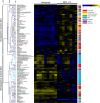Licofelone modulates neuroinflammation and attenuates mechanical hypersensitivity in the chronic phase of spinal cord injury
- PMID: 23303944
- PMCID: PMC3586230
- DOI: 10.1523/JNEUROSCI.6128-11.2013
Licofelone modulates neuroinflammation and attenuates mechanical hypersensitivity in the chronic phase of spinal cord injury
Abstract
Inflammation is a major factor shaping outcome during the early, acute phase of traumatic spinal cord injury (SCI). It is known that pro-inflammatory signaling within the injured spinal cord drives pathological alterations in neurosensory processing and shapes functional outcome early after injury. However, it is unclear whether inflammation persists into the chronic phase of injury or shapes sensory processing long after injury. To investigate these possibilities, we have performed biochemical and behavioral assessments 9 months after moderate thoracic spinal contusion injury in the rat. We have found that levels of the pro-inflammatory lipid mediators leukotriene B4 and prostaglandin E2 are elevated in the chronic spinal cord lesion site. Additionally, using metabolomic profiling, we have detected elevated levels of pro-oxidative and inflammatory metabolites, along with alterations in multiple biological pathways within the chronic lesion site. We found that 28 d treatment of chronically injured rats with the dual COX/5-LOX inhibitor licofelone elevated levels of endogenous anti-oxidant and anti-inflammatory metabolites within the lesion site. Furthermore, licofelone treatment reduced hypersensitivity of hindpaws to mechanical, but not thermal, stimulation, indicating that mechanical sensitivity is modulated by pro-inflammatory signaling in the chronic phase of injury. Together, these findings provide novel evidence of inflammation and oxidative stress within spinal cord tissue far into the chronic phase of SCI, and demonstrate a role for inflammatory modulation of mechanical sensitivity in the chronic phase of injury.
Figures







Similar articles
-
Reduction of pathological and behavioral deficits following spinal cord contusion injury with the selective cyclooxygenase-2 inhibitor NS-398.J Neurotrauma. 2001 Apr;18(4):409-23. doi: 10.1089/089771501750170994. J Neurotrauma. 2001. PMID: 11336442
-
The dual cyclooxygenase/5-lipoxygenase inhibitor licofelone attenuates p-glycoprotein-mediated drug resistance in the injured spinal cord.J Neurotrauma. 2013 Feb 1;30(3):211-26. doi: 10.1089/neu.2012.2587. Epub 2013 Jan 23. J Neurotrauma. 2013. PMID: 22947335 Free PMC article.
-
Oral administration of cytosolic PLA2 inhibitor arachidonyl trifluoromethyl ketone ameliorates cauda equina compression injury in rats.J Neuroinflammation. 2015 May 15;12:94. doi: 10.1186/s12974-015-0311-y. J Neuroinflammation. 2015. PMID: 25971887 Free PMC article.
-
Mechanisms of chronic central neuropathic pain after spinal cord injury.Brain Res Rev. 2009 Apr;60(1):202-13. doi: 10.1016/j.brainresrev.2008.12.010. Epub 2008 Dec 25. Brain Res Rev. 2009. PMID: 19154757 Free PMC article. Review.
-
Licofelone, a potent COX/5-LOX inhibitor and a novel option for treatment of neurological disorders.Prostaglandins Other Lipid Mediat. 2021 Dec;157:106587. doi: 10.1016/j.prostaglandins.2021.106587. Epub 2021 Sep 10. Prostaglandins Other Lipid Mediat. 2021. PMID: 34517113 Review.
Cited by
-
Neuroprotective effect of L-deprenyl on the expression level of the Mst1 gene and inhibition of apoptosis in rat-model spinal cord injury.Iran J Basic Med Sci. 2022 Jan;25(1):53-59. doi: 10.22038/IJBMS.2022.58031.12894. Iran J Basic Med Sci. 2022. PMID: 35656451 Free PMC article.
-
How is chronic pain related to sympathetic dysfunction and autonomic dysreflexia following spinal cord injury?Auton Neurosci. 2018 Jan;209:79-89. doi: 10.1016/j.autneu.2017.01.006. Epub 2017 Jan 27. Auton Neurosci. 2018. PMID: 28161248 Free PMC article. Review.
-
A COX/5-LOX Inhibitor Licofelone Revealed Anticonvulsant Properties Through iNOS Diminution in Mice.Neurochem Res. 2015 Sep;40(9):1819-28. doi: 10.1007/s11064-015-1669-z. Epub 2015 Jul 28. Neurochem Res. 2015. PMID: 26216049
-
Multiple organ dysfunction and systemic inflammation after spinal cord injury: a complex relationship.J Neuroinflammation. 2016 Oct 6;13(1):260. doi: 10.1186/s12974-016-0736-y. J Neuroinflammation. 2016. PMID: 27716334 Free PMC article. Review.
-
Parallel Metabolomic Profiling of Cerebrospinal Fluid and Serum for Identifying Biomarkers of Injury Severity after Acute Human Spinal Cord Injury.Sci Rep. 2016 Dec 14;6:38718. doi: 10.1038/srep38718. Sci Rep. 2016. PMID: 27966539 Free PMC article. Clinical Trial.
References
-
- Adibhatla RM, Hatcher JF. Lipid oxidation and peroxidation in CNS health and disease: from molecular mechanisms to therapeutic opportunities. Antioxid Redox Signal. 2010;12:125–169. - PubMed
-
- Aimone JB, Leasure JL, Perreau VM, Thallmair M. Spatial and temporal gene expression profiling of the contused rat spinal cord. Exp Neurol. 2004;189:204–221. - PubMed
-
- Alexander JK, Popovich PG. Neuroinflammation in spinal cord injury: therapeutic targets for neuroprotection and regeneration. Prog Brain Res. 2009;175:125–137. - PubMed
-
- Baastrup C, Finnerup NB. Pharmacological management of neuropathic pain following spinal cord injury. CNS Drugs. 2008;22:455–475. - PubMed
-
- Baker M. Metabolomics: from small molecules to big ideas. Nat Methods. 2011;8:117–121.
Publication types
MeSH terms
Substances
Grants and funding
LinkOut - more resources
Full Text Sources
Other Literature Sources
Medical
